Flood Recovery in the Far East
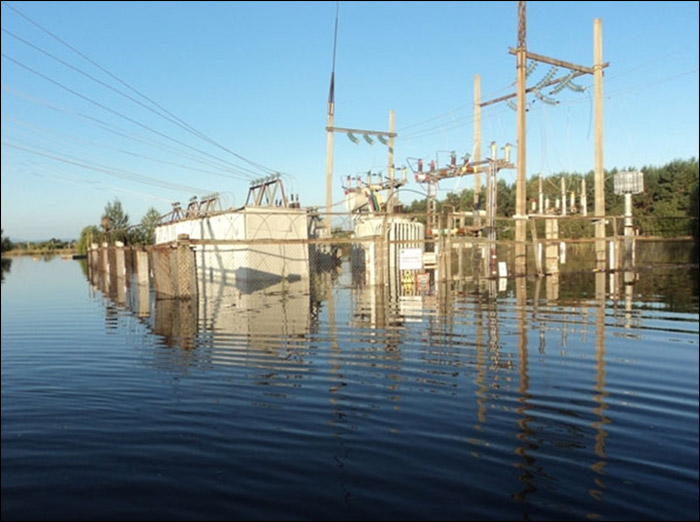
Two base stations left the network - the Amur Region.
At the end of July, after prolonged rains from June in Yakutia, the Trans-Baikal Territory and Northern China, the water level in Amur began to rise to critical levels. The situation worsened after the annual rainfall fell in the Khabarovsk Territory, the Amur Region and the Jewish Autonomous Region in early August. This led to a devastating flood, during which 120 settlements were affected. All this did not happen suddenly, so we managed to mobilize technical reserves to ensure the reliable operation of mobile communications.
In fact, the flood began on August 7:around 13:00 there was a sharp increase in the load on infrastructure in the Blagoveshchensk district of the Amur Region. By 14:00, the load exceeded the New Year peak by 1.5 times. Thanks to the work of emergency workers, it was possible to protect key objects, and thanks to the network scheme, which implies overlapping from neighboring base stations, it was possible to maintain coverage due to signal amplification.
The most difficult situation was in Komsomolsk-on-Amur.
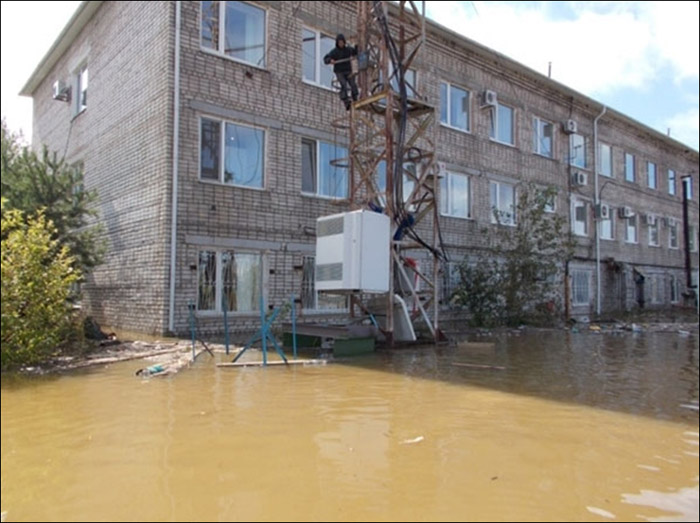
Near Komsomolsk-on-Amur. The equipment was moved from the ground to a temporary stand. By the time the work was completed, the water was 10 centimeters from the equipment.
According to the deteriorated forecast of meteorologists, the building in which the switching center is installed fell into the zone of possible flooding. In the event of flooding of the switch without communication, approximately 300 thousand subscribers could remain. Therefore, an airtight fence 30 meters long was quickly installed around the perimeter of the building. We built dams from sandbags (it took about 2 thousand bags), put 2 motor pumps. With the help of the Krai government, a second diesel generator was delivered from Khabarovsk, and the necessary fuel supply was increased. On the switch made a supply of water, food and medicine. Also bought boots and gasoline. Almost every hour, the water level in the storm sewer was checked - the first threat of flooding came from there. As a result, Komsomolsk-on-Amur did not remain without a connection with the outside world for a minute - it was possible to keep the line.
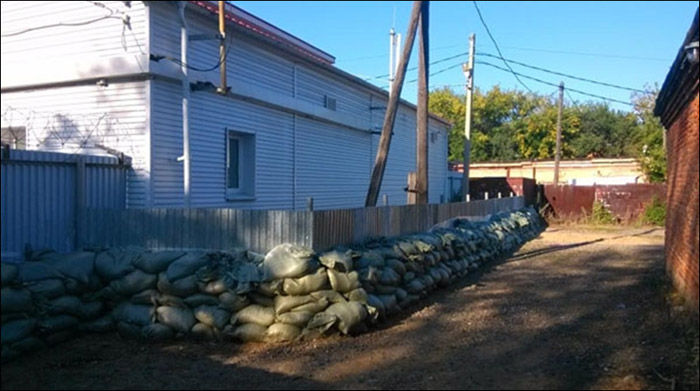
Protecting the building with a barricade of bags

Construction fencing near the switchboard
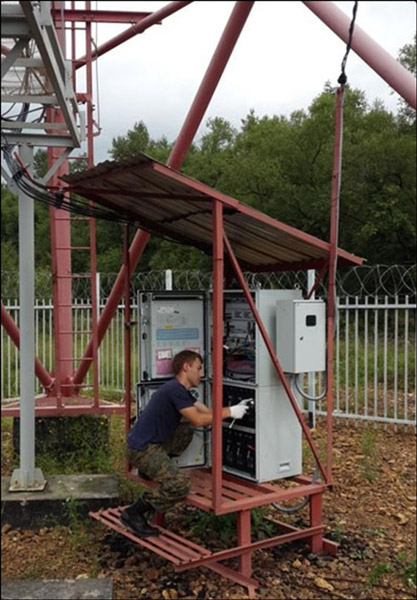
Dismantling to protect equipment from high water. In the photo, Marat Davlatmamadov is an engineer for the operation of the mobile and transport network, technical directorate of Huawei Service Technologies, Birobidzhan branch.
During the flood in the Amur Region , three stations were damaged in the villages of Ust-Ivanovka, Vladimirovka and Kasatkino. The containers were flooded, but the equipment was partially saved by the efforts of the technical directorate and the operations support department.
In the Khabarovsk Territoryand EAO, we knew about the arrival of water in advance, and understood what territory the flood would go through. At each point, backup power supplies with the necessary fuel supply were prepared, and additional emergency crews were organized. The state and readiness of facilities and communication lines falling into areas of possible flooding were checked, and network monitoring was strengthened. A week later, 7 base stations were flooded. Modules went up to the towers, the equipment was dismantled from the hardware and protected - there were no interruptions in communication. Our employees took an active part in preventing communication interruptions in the affected areas: they dismantled and removed equipment from flood zones, participated in emergency recovery work, often helped once competitors - and now just colleagues.
In total, 12 base stations were flooded during the flood, half of them in the Khabarovsk Territory. Another 12 base stations were raised above water level.

Emergency service engineer at the time of arrival at one of the sites
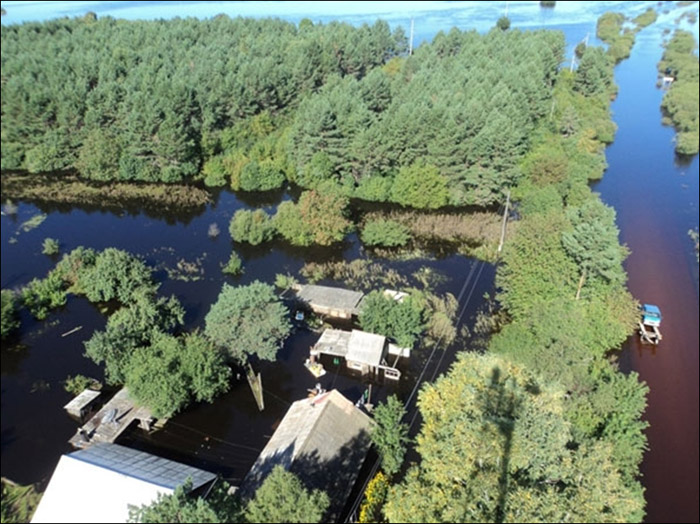
Some settlements began to look something like this
In Kukelevo, the station escaped - it was on a hill, so it provided a connection for several daredevils who decided to survive the flood in the village and protected their property from looters.
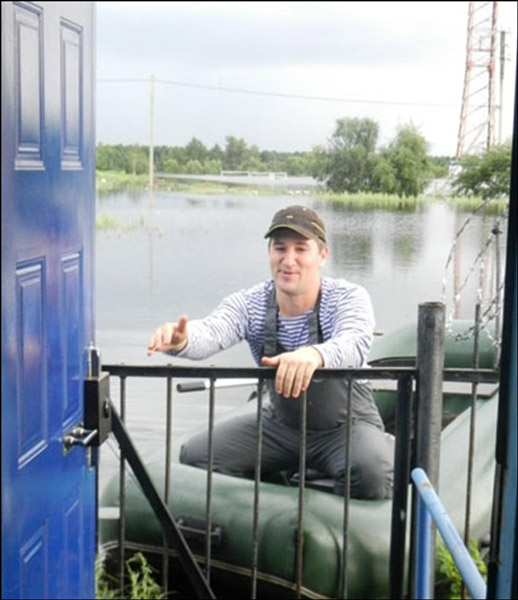
Dismantling equipment. In the photo, Grigory Pilipenko, head of the network construction department of the Amur branch.
In the villages of Nizhneleninsky and Newwe lost two stations. In the village of Dezhnev, the Leninsky district had to be disconnected due to the risk of flooding. In the villages of Leninsky and Blessed, as well as in the villages of Amurzet and Radda, they managed to raise the main equipment by 1-2 meters, which was enough for protection. In the village of Babstovo, where the operational headquarters of the Ministry of Emergency Situations and the temporary accommodation center for evacuated residents were concentrated, as well as in the village of Amurzet, additional batteries were added to increase the battery life of the stations in the event of a blackout.
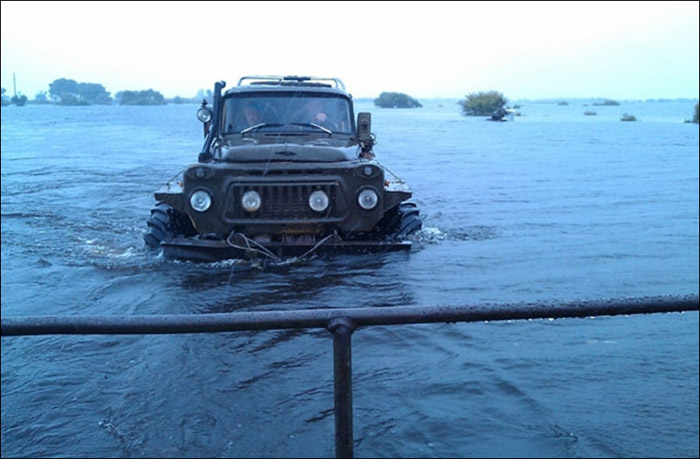
Resident's car Amurzet EAO involved in rescue operations
The headquarters of the Ministry of Emergencies and the local residents concentrated around it increased the load on the local section of the network, first by 20% of the calculated, then by 40%. We have expanded the capacity of voice channels by 150-200% depending on the object.

This station continued broadcasting. Pictured is Vladimir Vasilevich, senior engineer for the construction of a mobile access network.
Along with providing the population of the flooded territories with high-quality communication, Beeline provided communication to those who left their homes (and this is a total of about 17 thousand people). In temporary accommodation centers for the victims, we deployed contact points and gave phones for free calls to relatives.
In the affected communities, most often people were left with telephones, but without communication. Therefore, we handed out free payment cards so that people could talk with relatives. There were few phones in the two settlements, so we left the victim on our “handset” with a SIM card with an unlimited tariff, they all used them together.
Centrally, we sent aid to Klyuchi, Volkovo, Gribskoye, Kalinino, Konstantinovka, Krestovozdvizhenka, Poyarkovo in the Amur Region; Babstovo (TAC House of Culture and Agricultural College), Pronkino (TAC camp "Scarlet Sails"), Razdolnoe (TAC camp "Pearl"); Priamursky (TAC House of Culture), Nikolaevka (TAC school No. 7), Obluchye (TAC "PU-6") in the Jewish Autonomous Region.
Work with other teams
MTS and Megafon fought with us for every minute of uptime. Megafon deployed a mobile base station in Ivanovka, where there were simply no other channels. MTS in the village of Slavyanka deployed a new pre-fabricated station. Rostelecom installed 10 new satellite communication terminals, and also provided temporary accommodation centers with communications. I don’t know how at the marketing level, but the technical services definitely worked shoulder to shoulder. The Huawei Technologies Services and Vertical Stroi DV companies provided even greater help - thanks to them, operational recovery of the flooded base stations was largely achieved.
At the station in the village of Kukelevo, Leninsky district of the EAO, the telephone connection of Rostelecom OJSC was lost. We promptly provided a channel from the village of Leninsky to Kukelevo to restore a fixed connection. A week later, "Megaphone" in the temporary accommodation of residents of flooded areas - with. Babstovo - restored its cellular communication network also through the Beeline transport channel.
Since August 24, we introduced emergency technical roaming - as in the same situation in Krymsk, any of the subscribers with a SIM card of any operator could use our network. According to the same scheme, an emergency call is made at 112 at the usual time, for example, the connection is forwarded through any available network of any operator.
Total
It is worth mentioning separately about the work of other people invisible to many, moreover, done long before the emergency.
Firstly, the trunk workers - thanks to their more than competent work, they managed to preserve transport channels. There was not a single point where the network was lost due to a fall in transport - moreover, we often helped other operators with our channels. Secondly, the network planning department - we probably managed to rejoice a hundred times how the places for the station were chosen correctly. This was especially noticeable in the Amur region. Thirdly, our professional paranoid is risk planning. Thanks to them, we had all the necessary resources in emergency warehouses, channels and equipment were duplicated as needed. Perhaps for many this will sound pathetic, but it is in such situations that you feel what it means to have a large company behind you. In this regard, I remember my grandfather from Kukelev completely cut off by water, who during a call to relatives said:
In conclusion, I would like to thank all those who helped to cope with this situation and are working with it now. Each region and each settlement has its own heroes. Now I want to separately name a number of names of people, without which we simply could not cope. This is only that part of the teams that I came across directly:
- Pavel Chaykin and Nadezhda Shablovskaya - they organized the provision of communications for the victims.
- Denis Makarenko - he coordinated the actions of engineers.
- Grigory Pilipenko, Artyom Petrov, Vladimir Vasilievich and Alexandra Kravtsova - in the villages of Ust-Ivanovka, Vladimirovka and Kasatkino, they rescued equipment from already flooded facilities
- Marat Davlatmamadov, Strelnikov Vitaliy, Andrey Chalykh, Alexander Kasatkin - engaged in the evacuation of equipment from flooding places, raised the equipment higher, participated in the expansion of the battery capacity at stations located in the risk zone.
- Alexander Ivanov - for coordinating actions to ensure work on the switch.
- Yuri Salnikov, Denis Trofimchuk - for the continuous solution of many tasks of ensuring network operability.
- Verkhoturov Dmitry - for his dedicated work and the use of non-standard measures to raise equipment above the level of flooding.
Now the situation has stabilized and the restoration of lost points has already been completed throughout the territory.
